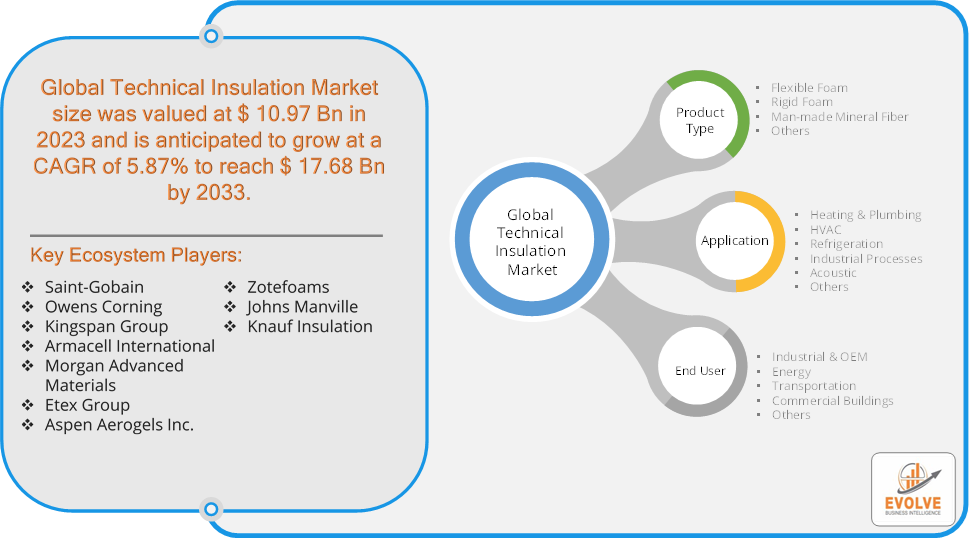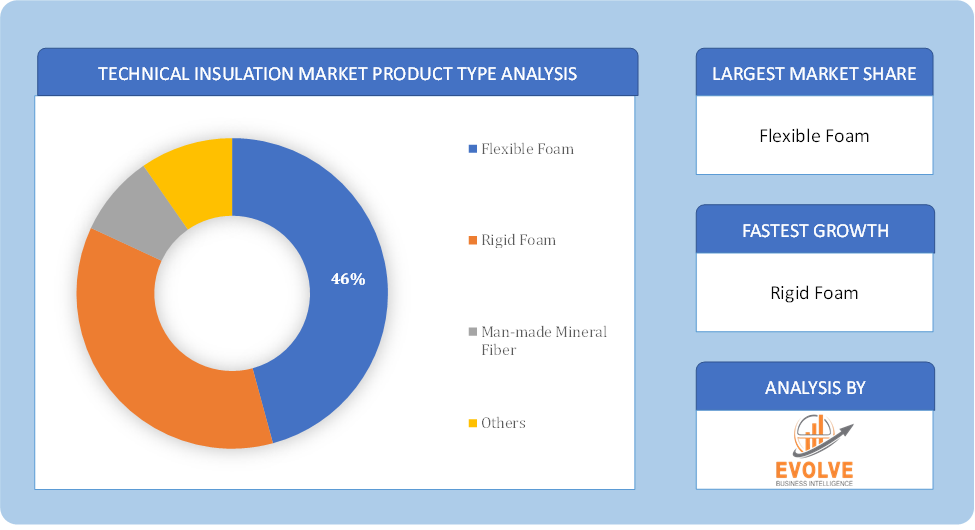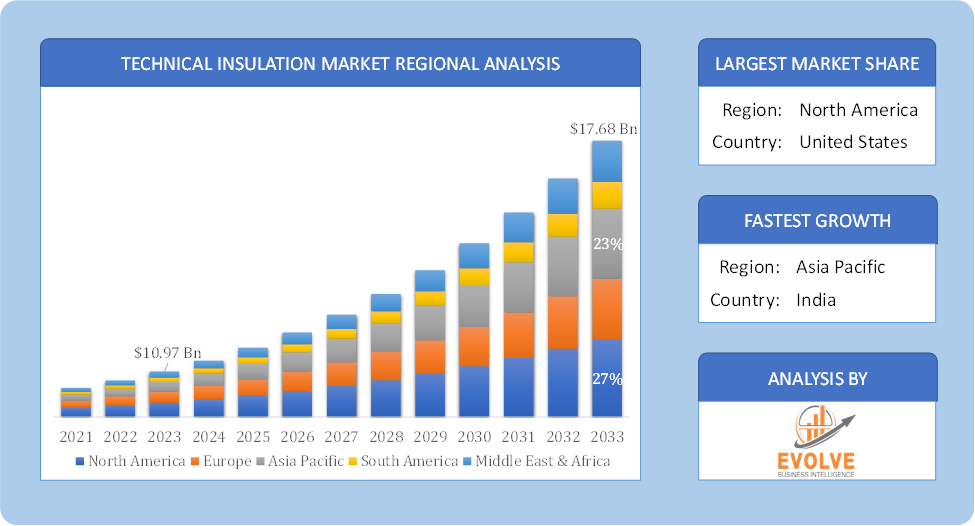Technical Insulation Market Overview
The Technical Insulation Market Size is expected to reach USD 17.68 Billion by 2033. The Technical Insulation Market industry size accounted for USD 10.97 Billion in 2023 and is expected to expand at a compound annual growth rate (CAGR) of 5.87% from 2023 to 2033. The Technical Insulation Market encompasses products designed to provide thermal and acoustic insulation in various industrial, commercial, and residential applications. Technical insulation includes materials used to control heat loss or gain, reduce noise, and enhance energy efficiency.
The market dynamics include factors such as technological advancements, increasing energy efficiency regulations, and growing awareness of sustainable building practices. The technical insulation market plays a crucial role in optimizing energy efficiency, enhancing safety, and improving the overall performance of industrial and commercial operations.
Global Technical Insulation Market Synopsis
 COVID-19 Impact Analysis
COVID-19 Impact Analysis
The COVID-19 pandemic had a significant impact on the Technical Insulation Market. The pandemic led to interruptions in the supply chain, including delays in the manufacturing and transportation of insulation materials. This disruption affected the availability of raw materials and finished products. The slowdown in construction and industrial activities during lockdowns reduced the demand for technical insulation in sectors such as residential and commercial construction, as well as industrial facilities. The focus on healthcare and essential infrastructure during the pandemic shifted some market priorities. However, the demand for insulation in healthcare facilities increased due to the need for maintaining temperature-sensitive environments. The pandemic heightened awareness of energy efficiency and sustainability. As economies began to recover, there was an increased focus on green building practices and energy-efficient solutions, which positively impacted the technical insulation market. Many companies had to adapt to remote work and reduced operations, affecting the workforce involved in the insulation industry and causing project delays.
Technical Insulation Market Dynamics
The major factors that have impacted the growth of Technical Insulation Market are as follows:
Drivers:
Ø Technological Advancements
Innovations in insulation materials and technologies, such as advanced composite materials and improved manufacturing processes, drive market growth by offering better performance and efficiency. The increasing focus on building energy-efficient structures, including retrofitting existing buildings, supports the demand for high-performance insulation solutions. The integration of insulation materials with smart technologies, such as IoT sensors for monitoring and optimizing energy use, contributes to market growth. Rapid urbanization and infrastructure development, particularly in emerging markets, increase the need for insulation solutions to meet modern building standards and enhance living conditions.
Restraint:
- Perception of High Costs and Market Volatility
The cost of advanced insulation materials and technologies can be high, which may limit their adoption, especially in cost-sensitive projects or regions. Fluctuations in raw material prices and supply chain disruptions can affect the cost and availability of insulation products, impacting market stability. The cost and complexity of installing and maintaining certain insulation products may deter their use, particularly in retrofitting existing buildings.
Opportunity:
⮚ Technological Innovations
Advancements in insulation materials and technologies, such as nano-materials, advanced composites, and smart insulation solutions, offer opportunities to meet evolving market demands and performance requirements. The growth of the renewable energy sector, including solar and wind energy, creates opportunities for insulation products used in energy generation and storage systems. Integration of insulation materials with smart building technologies, such as IoT sensors for monitoring energy use and performance, offers new opportunities in the market.
Technical Insulation Market Segment Overview
 By Product Type
By Product Type
Based on Product Type, the market is segmented based on Flexible Foam, Rigid Foam, Man-made Mineral Fiber and Others. The man-made mineral dominant the market, as these man-made mineral fibers are fire resistant and can withstand temperatures up to 1,148 OF (620°C) when used in pipes. They can appropriately fit in a pipe segment and have good compression resistance. They support preserving the ideal temperatures of hot and cold pipes. They also aid in preventing condensation and can be utilized in acoustic insulation systems because they reduce noise.
By Application
Based on Application, the market segment has been divided into Heating & Plumbing, HVAC, Refrigeration, Industrial Processes, Acoustic and Others. The heating & plumbing segment dominant the market because of the necessity to prevent pipes from overheating while maintaining the heat inside the pipe. Technical insulation is being used increasingly often as a result of rising demand for more affordable insulated pipes with remarkable technical characteristics.
By End User
Based on End User, the market segment has been divided into Industrial & OEM, Energy, Transportation, Commercial Buildings and Others. The segment of industrial & OEM is expected to account for the highest market owing to the increase of Technical insulation across a variety of sectors as there is a growing need to lower energy costs and reduce CO emissions produced by companies each year to attain improved energy efficiency. Other factors driving the increase in the use of technological insulation in the industrial sector are rising energy costs and concerns about supply security as fossil fuel prices rise.
Global Technical Insulation Market Regional Analysis
Based on region, the global Technical Insulation Market has been divided into North America, Europe, Asia-Pacific, the Middle East & Africa, and Latin America. North America is projected to dominate the use of the Technical Insulation Market followed by the Asia-Pacific and Europe regions.
 Technical Insulation North America Market
Technical Insulation North America Market
North America holds a dominant position in the Technical Insulation Market. North America has some of the most stringent building energy codes and standards. Regulations such as the International Energy Conservation Code (IECC) and ASHRAE standards drive the demand for high-performance insulation materials to meet energy efficiency requirements. The region is a hub for innovation in insulation technologies. Advances in materials science have led to the development of superior insulation products, such as aerogels and phase-change materials, that offer better thermal and acoustic performance.
Technical Insulation Asia-Pacific Market
The Asia-Pacific region has indeed emerged as the fastest-growing market for the Technical Insulation Market industry. The Asia-Pacific region is experiencing significant urbanization and infrastructure growth, leading to increased construction activities. This drives the demand for insulation materials to ensure energy efficiency and thermal comfort in new buildings. Economic expansion in countries like China and India boosts the construction sector, industrial activities, and investments in modern infrastructure, which in turn drives the demand for technical insulation products.
Competitive Landscape
The global Technical Insulation Market is highly competitive, with numerous players offering a wide range of software solutions. The competitive landscape is characterized by the presence of established companies, as well as emerging startups and niche players. To increase their market position and attract a wide consumer base, the businesses are employing various strategies, such as product launches, and strategic alliances.
Prominent Players:
- Saint-Gobain
- Owens Corning
- Kingspan Group
- Armacell International
- Morgan Advanced Materials
- Etex Group
- Aspen Aerogels Inc.
- Zotefoams
- Johns Manville
- Knauf Insulation
Scope of the Report
Global Technical Insulation Market, by Product Type
- Flexible Foam
- Rigid Foam
- Man-made Mineral Fiber
- Others
Global Technical Insulation Market, by Application
- Heating & Plumbing
- HVAC
- Refrigeration
- Industrial Processes
- Acoustic
- Others
Global Technical Insulation Market, by End User
- Industrial & OEM
- Energy
- Transportation
- Commercial Buildings
- Others
Global Technical Insulation Market, by Region
- North America
- US
- Canada
- Mexico
- Europe
- UK
- Germany
- France
- Italy
- Spain
- Benelux
- Nordic
- Rest of Europe
- Asia Pacific
- China
- Japan
- South Korea
- Indonesia
- Austalia
- Malaysia
- India
- Rest of Asia Pacific
- South America
- Brazil
- Argentina
- Rest of South America
- Middle East & Africa
- Saudi Arabia
- UAE
- Egypt
- South Africa
- Rest of Middle East & Africa
| Parameters | Indicators |
|---|---|
| Market Size | 2033: USD 17.68 Billion |
| CAGR (2023-2033) | 5.87% |
| Base year | 2022 |
| Forecast Period | 2023-2033 |
| Historical Data | 2021 (2017 to 2020 On Demand) |
| Report Coverage | Revenue Forecast, Competitive Landscape, Growth Factors, and Trends |
| Key Segmentations | Product Type, Application, End User |
| Geographies Covered | North America, Europe, Asia-Pacific, South America, Middle East, Africa |
| Key Vendors | Saint-Gobain, Owens Corning, Kingspan Group, Armacell International, Morgan Advanced Materials, Etex Group, Aspen Aerogels Inc., Zotefoams, Johns Manville and Knauf Insulation. |
| Key Market Opportunities | · Technological Innovations · Smart Building Technologies |
| Key Market Drivers | · Technological Advancements · Urbanization and Infrastructure Development |
REPORT CONTENT BRIEF:
- High-level analysis of the current and future Technical Insulation Market trends and opportunities
- Detailed analysis of current market drivers, restraining factors, and opportunities in the future
- Technical Insulation Market historical market size for the year 2021, and forecast from 2023 to 2033
- Technical Insulation Market share analysis at each product level
- Competitor analysis with detailed insight into its product segment, Government & Defense strength, and strategies adopted.
- Identifies key strategies adopted including product launches and developments, mergers and acquisitions, joint ventures, collaborations, and partnerships as well as funding taken and investment done, among others.
- To identify and understand the various factors involved in the global Technical Insulation Market affected by the pandemic
- To provide a detailed insight into the major companies operating in the market. The profiling will include the Government & Defense health of the company’s past 2-3 years with segmental and regional revenue breakup, product offering, recent developments, SWOT analysis, and key strategies.


 Technical Insulation North America Market
Technical Insulation North America Market


